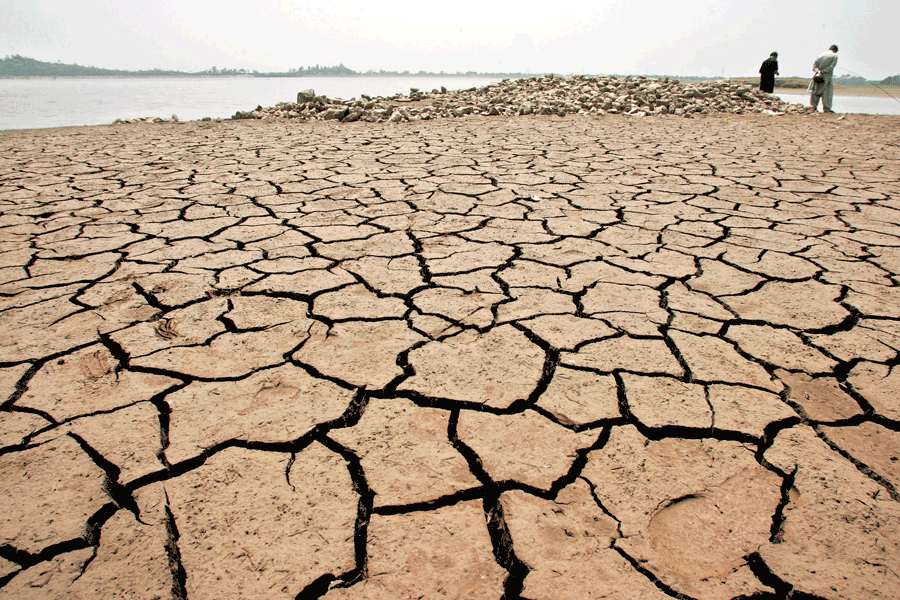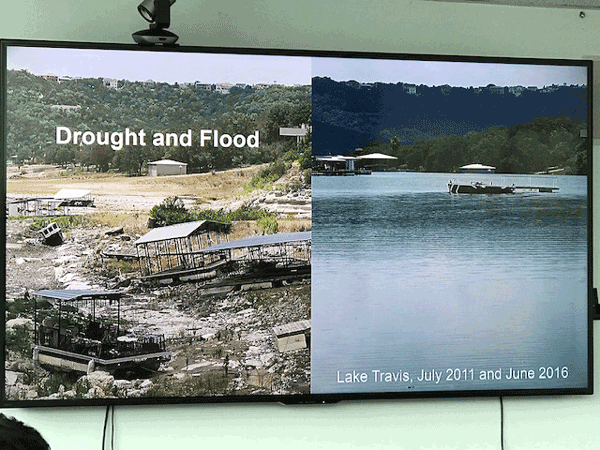Stressed Out
By Rina Saeed Khan | Environment | Published 6 years ago
Today the Indus River System, which supplies around 90 per cent of the waters for agriculture and only four to five per cent for domestic use and the rest for industry, is strained as a consequence of the growing demand from Pakistan’s burgeoning population. On top of it, we are faced with climate change, which is not just melting the glaciers in the mountains, but changing snowmelt and precipitation patterns.

Pakistan increasingly faces vicious cycles of water shortage and drought.
As rainfall becomes more erratic, water supply becomes less reliable and the days become hotter, more water evaporates from lakes and reservoirs while the demand continues to rise. According to a new report brought out by the World Resources Institute in August this year, 17 countries now have to deal with “extremely high” water stress – Pakistan ranks at number 14. Many of these water-stressed countries, including Pakistan, face the danger of both floods and droughts.
Like Pakistan, the water-scarce states of Texas and California also face floods and droughts due to global climate change. The US receives a lot of rain in its eastern states, where there are a lot of rivers as well; however its western states are mostly dry. There is, in fact, a federal “Bureau of Reclamation” that manages water in 17 western states from land that has been “reclaimed” from the desert.
As one learnt on a recent journalist’s tour of the US on the topic of ‘Creating a more water-secure future’ organised by the State Department, there are many lessons for Pakistan. Foremost among them is that it is not about how much water you have, but how you manage it. Americans are determined to ensure sustainable supplies of water for their citizens given that rainfall patterns are changing all over the world.

In Texas, cycles of floods and droughts are expected to become more extreme with climate change.
In fact, the Texans may deny the fact that man-made climate change is happening in their Republican-led capitol, where legislation is passed, yet the state is preparing for a hotter future, with more extreme weather disasters like hurricanes and severe droughts. The Californians didn’t even vote for President Trump, who is pulling the US out of the Paris Agreement to curb global carbon emissions, and they are doing all they can to both prevent and adapt to climate change.
They, too, are facing extended droughts and a phenomenon called “atmospheric rivers,” when heavy rains hit California. We, in Pakistan, do not deny that climate change is happening. However, when it comes to climate change exacerbating water shortages in Pakistan, there is no comprehensive plan in place.
Pakistan’s National Water Policy, which was approved last year, covers all water-related issues, from climate change to irrigation and clean drinking water. But water experts like Dr Pervaiz Amir have questioned whether the 36 page-long policy with its extensive data could be converted into a solid plan of action. “We don’t know what the key priorities are – what are the three or four things that we need to do urgently?” he asks. Since 90 per cent of our water is used for agriculture, that is where we should be concentrating on reducing the greatest wastage of water.
Unfortunately, that is not the case. We use more water per crop than in most other places. We need to enforce cropping zones and focus on drought-resistant varieties of crops and efficient irrigation practices using innovative technology. So what can Pakistan learn from water-scarce California and Texas, where water management is approached in a decentralised manner?
In California, where they face cycles of drought years and wet years, all farmers use sprinkler systems to grow high-end crops like grapes and almonds. However, farmers have to compete with cities to meet their water demands. Sometimes cities even pay farmers to stop them from growing crops during seasons when there are extreme water shortages. In urban areas, they are ensuring that people use half-flush toilets to cut water usage, and each city figures out a water pricing system on its own.
Austin, the capital of Texas, has even prepared a 100-year water plan with a strong focus on conservation and reuse of water through storage strategies (an aquifer storage and recovery pilot site is also being selected). Austin’s ‘Water Forward’ strategy looks at all sources of water – including rainwater, storm water and wastewater – as possible resources to meet community needs. Just imagine all the rainwater that fell on Karachi this month – all wasted as probably it has found its way into the sea by now.
Throughout our tour of Austin, we were told that “Water, not oil, is the lifeblood of Texas.” We met with the Texas Water Development Board, which was formed in 1957 after a decade-long drought in Texas, and their planning is “built on science” with a bottom-up approach. This is an intelligent approach as water issues vary from one area to another – even in Pakistan some parts get more water (Punjab and Khyber Pakhtunkhwa), others less (Sindh and Balochistan).
Texans rely mostly on aquifers and man-made reservoirs, which are owned by the state, for their water, but Texans have the right to drill as much groundwater as they can on the land they own. However, depleting groundwater is leading to local governments moving to regulate it at the district level. This is something that is expected to happen in Pakistan as well, where there is no regulation on the use of groundwater.
Farmers on Pakistan’s plains are draining aquifers to grow water-intensive crops like sugar, cotton and rice, and no one is stopping them at the district or provincial level. There is an urgent need to grow less thirsty crops, but who in the government will confront the powerful sugar and cotton barons?

Austin, Texas: Barton Springs is fed by an aquifer protected by the government.
Texans, on the other hand, understand the need to maintain a balance in the use of aquifers, and in some cases they have even gone to court and won. The prime example of this was when the court ordered the preservation of Barton Springs, an aquifer in Austin, which is now a natural swimming pool open to the public. We also visited the Meadows Centre for Water and the Environment, an educational centre in San Marcos dedicated to the preservation of Spring Lake, which is fed by the Edwards aquifer.
We were told that Texans know the value of water and it is allocated at a price. Those who pay more get more regular supplies. Americans are also looking to invest in water reuse and desalination in both Texas and California in the near future. Called direct potable reuse or ‘toilet to tap,’ we visited one plant in San Diego called ‘Pure Water,’ where we learnt that 85 per cent of the water is imported in California.
Given the rising costs of imported water, there is a multi-faceted approach to saving water in California: conservation, desalination, groundwater development and recycled water. Did you know that all the water in the world has been recycled since the time of the dinosaurs? Today the astronauts on the international space station recycle all their water.
Pure Water San Diego is a demo plant for now – it is not distributing the clean drinking water it produces to communities directly as yet, but it is sending the clean water back to the reservoirs, where it is used for irrigation and industrial purposes. They told us that they do not have regulations as yet in California for the recycled water to be supplied directly as potable water, but they are working on it.
We toured the demo plant, which produces one million gallons a day after the dirty water is passed through ozonation, carbon filters, membrane filtration, reverse osmosis and ultra violet disinfection. The end product, they explained, was a “safe, reliable, sustainable water supply for generations to come.” They aim to produce one-third of the local water for local use by 2035.
Some communities, however, are concerned about “drinking toilet water,” even though it has been through an extensive filtration process. Hence, there is a lot of community outreach by Pure Water and they are trying to “overcome the barriers of public approval.” They remind people that cheaper water is needed, especially as the population multiplies in California. They told us that they would charge communities only “what it takes us to produce it.”
In the next 10 years, both California and Texas will also turn to desalination, which is twice as expensive as water from other sources, but it will ensure a “drought-free supply.” We also managed to visit a desalination plant in Carlsbad, near San Diego. Called the Claude ‘Bud’ Lewis Desalination Plant (named after a local mayor), it is located next to the Pacific Ocean and they currently serve 3.3 million people in the area with clean, desalinated water.
Here the emphasis is on “reliability” and “local control of supply.” Setting up a desalination plant, however, is a long process and they had to first get environmental clearances etc. They produce expensive water but for some areas it is the only option, and there is plenty of public support for recycled seawater.
Pakistan’s upcoming Gwadar city is now relying on water from two desalination plants – one inside the port that was set up by the Chinese, and the other in the city constructed by the Pakistan army which is providing 200,000 gallons of water daily since last year. It is expensive water as it requires a lot of energy to remove salt from water molecules but there was no other option in Gwadar. It barely rains in Gwadar nowadays and the water had to be trucked in from afar. Currently, Israel is the world leader in desalination and they provided technical guidance to the Carlsbad plant.
Pakistan needs more programmes like water harvesting, desalination, wastewater treatment, recycling and reuse technologies. All this will require the participation of local communities. Experts are warning that if the world doesn’t improve its agricultural efficiency, decrease its water use and recycle and reuse wastewater, water scarcity could pose a permanent stress in the future.


